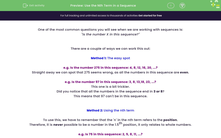One of the most common questions you will see when we are working with sequences is:
"Is the number X in this sequence?"
There are a couple of ways we can work this out:
Method 1: The easy spot
e.g. Is the number 275 in this sequence: 4, 8, 12, 16, 20, ...?
Straight away we can spot that 275 seems wrong, as all the numbers in this sequence are even.
e.g. Is the number 97 in this sequence: 3, 8, 13,18, 23, ...?
This one is a bit trickier.
Did you notice that all the numbers in the sequence end in 3 or 8?
This means that 97 can't be in this sequence.
Method 2: Using the nth term
To use this, we have to remember that the 'n' in the nth term refers to the position.
Therefore, it is never possible to be a number in the 1.5th position, it only relates to whole numbers.
e.g. Is 75 in this sequence: 2, 5, 8, 11, ...?
Step 1: Find the nth term of the sequence.
For this sequence, our nth term would be 3n - 1.
Step 2: Make this nth term equal to the number you are looking for and then solve the equation.
3n - 1 = 75
3n = 76
n = 25.3333
Because n isn't a whole number, this means that 75 cannot be in this sequence.
e.g. Is 224 in this sequence: 8, 14, 20, 26, ...?
Step 1: Find the nth term of the sequence.
For this sequence, our nth term would be 6n + 2.
Step 2: Make this nth term equal to the number you are looking for and then solve the equation.
6n + 2 = 224
6n = 222
n = 37
Because n is a whole number, 224 is in this sequence.
In this activity, we will use the nth term to confirm if a number does or does not appear in a given sequence. If we can, we will use the 'easy spot' method first in order to save time and effort.








